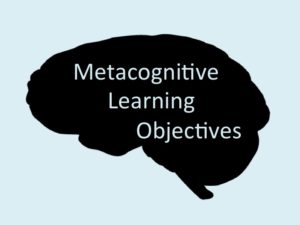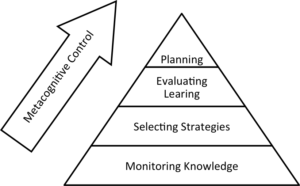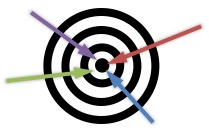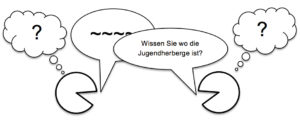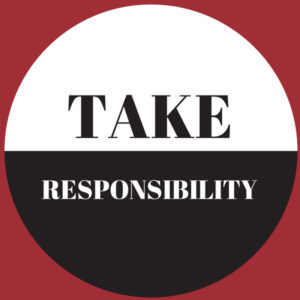by Patrick Cunningham, Ph.D., Rose-Hulman Institute of Technology
Teaching through the COVID-19 pandemic has highlighted disparities in how students approach their learning. Some have continued to excel with hybrid and online instruction while others, and more than usual, have struggled. Compounding these struggles, these students also find themselves behind or with notable gaps in their prerequisite knowledge for following courses. A significant component of these struggles may be due to not having developed independence in their learning. Engaging in explicit metacognitive activities directly addresses this disparity, improving students’ abilities to overcome these struggles. Given the present challenges of living through COVID-19, this is more important now than ever. However, creating activities with metacognitive focus is likely unfamiliar and there are not a lot of resources to guide their development. Here I seek to demonstrate an accessible approach, an entry point, for supporting students’ growth as more skillful and independent learners grounded in metacognition.
Cognitive Learning Objectives are Just the Start
Creating explicit learning objective is one means by which educators commonly try to support students’ independence in learning. Typically learning objectives focus on the cognitive domain, often based on Bloom’s Taxonomy. The cognitive domain refers to how we think about or process information. Bloom’s taxonomy for the cognitive domain is comprised of Remembering, Understanding, Applying, Analyzing, Evaluating, and Creating (Krathwohl, 2002). Each of these gives an indication how a student is expected to engage or use the material we are teaching. For constructing learning objectives, there are lists of action verbs associated with each Bloom category.
Consider this cognitive learning objective for a computer programming course.
Students will be able to create and implement functions with inputs and an output in C++ programs to accomplish a specified task on an Arduino board with a prewired circuit.
This learning objective is specific to a lesson and targets the Apply level of Bloom’s taxonomy. (The approach I am presenting could equally apply to broader course-level learning objectives, but I think the specificity here makes the example more tangible.) This objective uses good action verbs (bolded) and has a prescribed scope and context. But is it adequate for guiding student learning if they are struggling with it?
Metacognitive Learning Objectives can Direct Learning Activities
Cognitive learning objectives point students to what they should be able to do with the information but do not usually provide guidance for how they should go about developing their ability to do so. Metacognition illuminates the path to developing our cognitive abilities. As a result, metacognitive training can support students’ attainment of cognitive learning objectives. Such training requires metacognitive learning objectives.
Metacognitive learning objectives focus on our awareness of the different ways we process information and how we regulate and refine how we process information. Metacognitive knowledge includes knowledge of how people (and we as individuals) process information, strategies for processing information and monitoring our thinking, and knowledge of the cognitive demands of specific tasks (Cunningham, et al., 2017). As we engage in learning we draw on this knowledge and regulate our thinking processes by planning our engagement, monitoring our progress and processes, adjusting or controlling our approaches, and evaluating the learning experience (Cunningham, et al., 2017). Metacognitive monitoring and evaluation feed back into our metacognitive knowledge, reinforcing, revising, or adding to it.
Example Implementation of Metacognitive Learning Objectives
Considering our example cognitive learning objective, how could we focus metacognitive training to support student attainment of it? Two possibilities include 1) focusing on improving students’ metacognitive knowledge of strategies to practice and build proficiency with writing functions or 2) supporting students’ accurate self-assessment of their ability to demonstrate this skill. Instructors can use their knowledge of their students’ current strategies to decide which approach (or both) to take. For example, if it appears that most students are employing limited learning strategies, such as memorizing examples by reviewing notes and homework, I might focus on teaching students about a wider range of effective learning strategies. The associated metacognitive learning objective could be:
Students will select and implement at least two different elaborative learning strategies and provide a rationale for how they support greater fluency with functions.
The instructional module could differentiate categories of learning objectives (e.g., memorization, elaboration, and organization), demonstrate a few examples, and provide a more complete list of elaborative learning strategies (Seli & Dembo, 2019). Then students could pick one to do in class and one to do as homework. If, on the other hand, it appears that most students are struggling to self-assess their level of understanding, I might focus on teaching students how to better monitor their learning. The associated metacognitive learning objective could be:
Students will compare their function written for a specific application, and completed without supports, to a model solution, using this as evidence to defend and calibrate their learning self-assessment.
Here the instructional module could be a prompt for students to create and implement a function, from scratch without using notes or previously written code. After completing their solutions, students would be given access to model solutions. In comparing their solution to the model, they could note similarities, differences, and errors. Then students could explain their self-assessment of their level of understanding to a neighbor or in a short paragraph using the specific comparisons for evidence. These examples are metacognitive because they require students to intentionally think about and make choices about their learning and to articulate their rationale and assessment of the impact on their learning. I believe it is important to be explicit with students about the metacognitive aim – to help them become more skillful learners. This promotes transfer to other learning activities within the class and to their learning in other classes.
Implementing and Supporting Your Metacognitive Outcomes
In summary, to create actionable metacognitive learning objectives I recommend,
- clarifying the cognitive learning objective(s) you aim to support
- investigating and collecting evidence for what aspect(s) of learning students are struggling with
- connecting the struggle(s) to elements of metacognition
- drafting a metacognitive learning objective(s) that address the struggle(s)
Armed with your metacognitive learning objectives you can then craft metacognitive training to implement and assess them. Share them with a colleague or someone from your institution’s teaching and learning center to further refine them. You may want to explore further resources on metacognition and learning such as Nilson’s (2013) Creating Self-Regulated Learners, Seli and Dembo’s (2019) Motivation and learning strategies for college success, and Svinicki’s GAMES© survey in (Svinicki, 2004). Or you could watch my Skillful Learning YouTube video, What is Metacognition and Why Should I Care?.
If metacognition is less familiar to you, avoid overwhelm by choosing one element of metacognition at a time. For example, beyond the above examples, you could focus on metacognitive planning to support students better navigating an open-ended project. Or you could help students better articulate what it means to learn something or experience the myth of multitasking (we are task switchers), which are elements pertaining to metacognitive knowledge of how people process knowledge. Learn about that element of metacognition, develop a metacognitive learning objective for it, create the training materials, and implement them with your students. You will be supporting your students’ development as learners generally, while you also promote deeper learning of your cognitive course learning objectives. Over time, you will have developed a library of metacognitive learning objectives and training, which you could have students explore and self-select from based on their needs.
Acknowledgements
This blog post is based upon metacognition research supported by the National Science Foundation under Grant Nos. 1932969, 1932958, and 1932947. Any opinions, findings, and conclusions or recommendations expressed in this material are those of the author and do not necessarily reflect the views of the National Science Foundation.
References
Cunningham, P. J., Matusovich, H. M., Hunter, D. A., Williams, S. A., & Bhaduri, S. (2017). Beginning to Understand Student Indicators of Metacognition. In the proceedings of the American Society for Engineering Education (ASEE) Annual Conference & Exposition, Columbus, OH.
Krathwohl, D. R. (2002). A revision of Bloom’s taxonomy: An overview. Theory into practice, 41(4), 212-218.
Nilson, L. (2013). Creating self-regulated learners: Strategies to strengthen students? self-awareness and learning skills. Stylus Publishing, LLC.
Seli, H., & Dembo, M. H. (2019). Motivation and learning strategies for college success: A focus on self-regulated learning. Routledge.
Svinicki, M. D. (2004). Learning and motivation in the postsecondary classroom. Anker Publishing Company.
